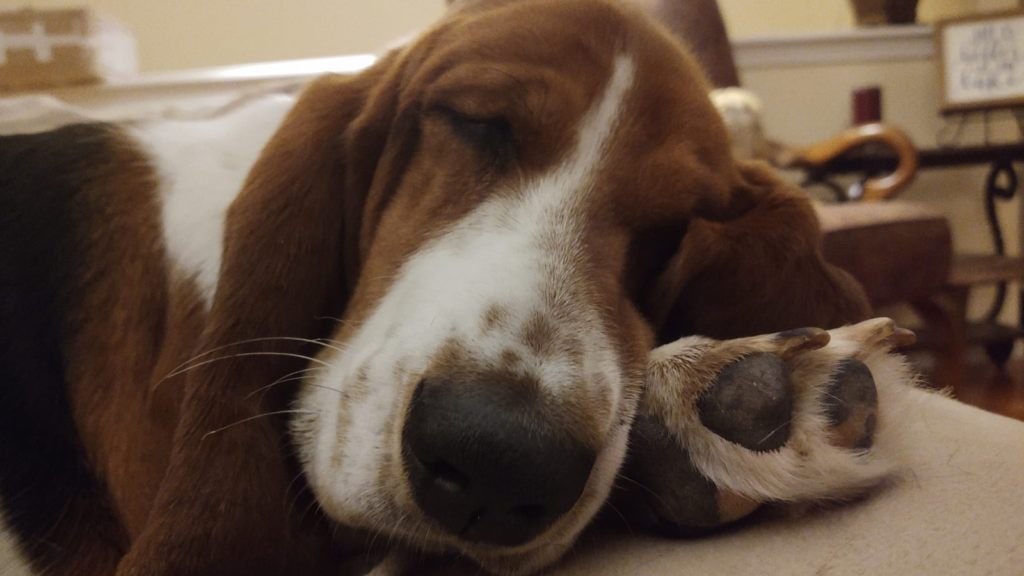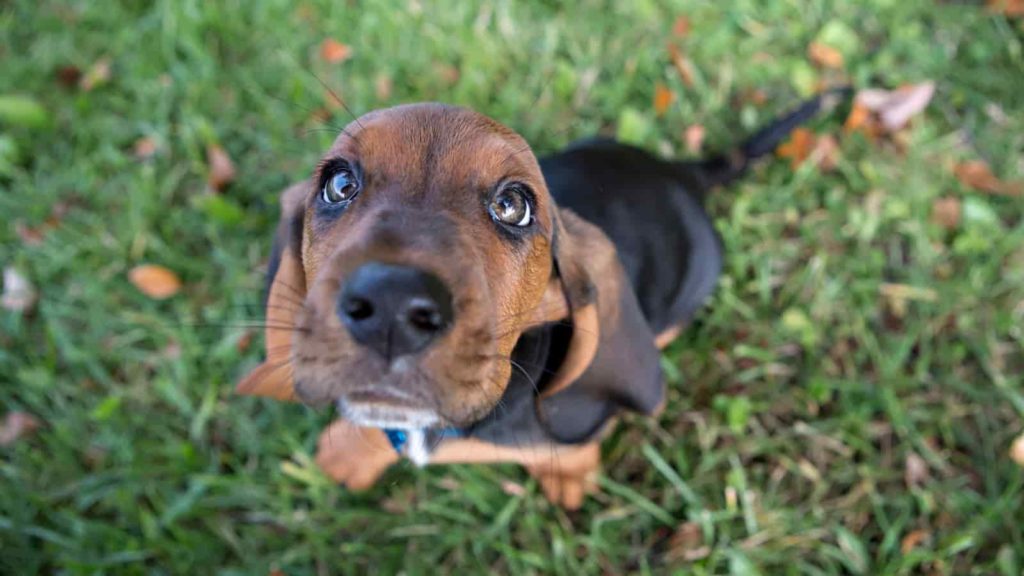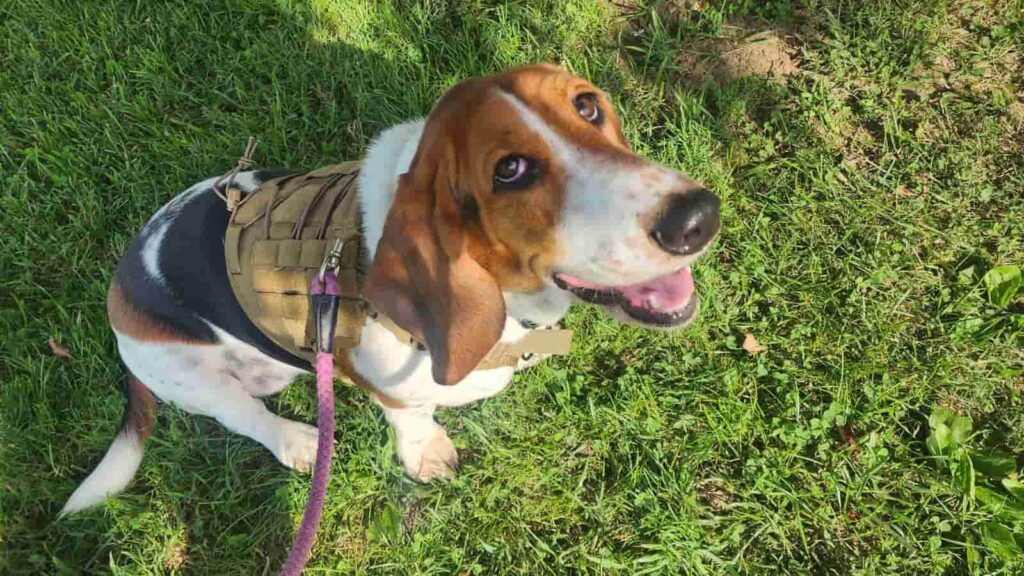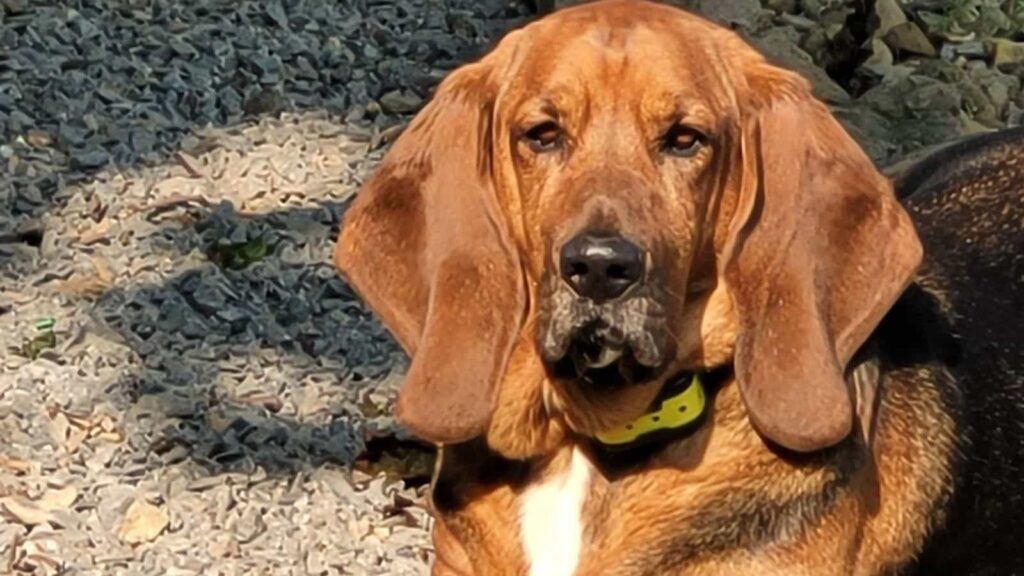Many Basset Hound owners already know that this breed is one of the most loving and loyal breeds around. But this breed is also very independent, which can be difficult when trying to train them.
Unfortunately, many Basset Hound owners struggle when trying to train their dogs in different areas such as obedience, leash, crate, and potty training.
There are many different training methods used to improve a Basset Hound’s ability to recall commands given to them by their owners. Some methods include positive reinforcement, consistency, maintaining a schedule, etc.
If you are interested in learning more about how to train a Basset Hound and the many different training options, then keep reading!

Are Basset Hounds Hard to Train?
When considering getting a dog, owners sometimes worry whether or not the breed they choose will be hard to train or not.
Basset Hounds are one of the most independent dog breeds because of their history as hunting dogs, making them harder to train than some other breeds.
Thankfully, with the right training methods, a Basset Hound can be trained very well in a decent amount of time.
Basset Hounds are very smart, ranking in intelligence at #71 among dog breeds. Their smartness can lead to them having very strong mindsets and not responding to training well.
Disclaimer: This post may contain affiliate links. We only recommend high-quality products that are used and recommended by real owners. If you use these links to buy something we earn a small commission.
Working closely with your Basset Hound and keeping a consistent training schedule is key if you are trying to train your dog.
How to Train a Basset Hound?
Training is one of the most important aspects that a lot of dog owners consider when getting a dog. If a dog is not trained properly many issues can arise over time as the puppy grows older.
One of the most beneficial ways to begin training a Basset Hound is to start their training as early as possible. This breed responds best to positive reinforcement methods of training.
Positive reinforcement training is when a reward is given to the dog when they do the behavior that the owner/trainer has encouraged them to do, this is one training method that works great for all dog breeds.
Basset Hounds specifically respond well to this type of training in comparison to other training methods. If they know they will get a reward, they are even more eager to please their owner/trainer.
Basset hounds also respond well to praise. Because they are independent, they are oftentimes distracted and have their minds set on things other than training.
By working with them and giving them consistent praise, especially when they are young, Basset Hounds will usually respond very well to training.
NOTE: The longer you wait to train a Basset Hound, the harder it will be to get results.
Basset Hounds are known for specific behaviors and habits that their owners are oftentimes eager to break, here are a few of their most common behaviors/habits:
- Chewing (especially furniture and shoes laying around)
- Jumping
- Begging for food
- Chasing other animals
- Growling
- Barking
- Refusing to listen
One owner suggested being “persistent and consistent” is key when training a Basset Hound. While it is sometimes hard to train this breed, once they are trained, they are one of the best dog breeds around!
As mentioned above, beginning training early as a puppy is the best way to train a Basset Hound. Owners who waited to train their dog stated that it took even longer to see results.

Basset Hound Training Tips
Some dog owners think of training as one specific behavior, action, etc., but there are many different areas of life that dogs must be trained in.
Basset Hounds are typically potty trained, leash trained (walking), and oftentimes crate trained.
Before we dive deeper into the specifics of these training methods, here are some tips for general training:
- Keep a consistent routine
- Motivate your dog
- Use the same signals and commands each time so there is no confusion.
- Don’t try training in all areas at once (ex: work on potty training and leash training separately.)
- Socialize your dog early
- Positive reinforcement (give treats/praise when they behave good)
- Make sure your dog is happy and comfortable or else they are not going to respond well to training.
- Exercise your dog regularly
- Help your dog maintain a good diet, this can help them focus, behave, and feel better overall.
NOTE: Basset Hound owners who have given their dog treat rewards during training said that their dog will do the task that they have asked them to do almost 100% of the time.
If your Basset Hound is taking longer to train than you hoped, don’t give up! Some owners said that it took 6–8 months to potty train their Basset Hound.
This is why it is important to begin training early. If you begin training a Basset Hound puppy, you may see results in as little as a week, whereas if you wait and train an older Basset Hound, it may take weeks and many repetitions.
Each dog is different, as long as you maintain consistency and patience, you should be able to train your Basset Hound easily!
NOTE: Oftentimes Basset Hound puppies are eager to please their owners, so they are quick to catch on to training and follow the commands faster/better.
Other options can be used for training that is not directly related to the owner or trainer, here are a few:
- Using a doggy door — This gives the dog the option to have freedom and go in and out of the house as they please, sometimes this can help them potty train faster.
- Fence in the yard — Some Basset Hounds will train better off-leash. If there is a fence where the dog can be off-leash, it may respond to training differently.
- Keep your dog’s designated area closed off by a gate — By giving your dog their own area, they will be less likely to chew up things and they will typically potty train quickly because they don’t like the thought of doing their business in the area where they eat and sleep.
- Training signals — Some owners have trained their dogs to use signals to indicate what they need. For example, one owner keeps a bell by the door, and when their Basset Hound needs outside, they ring the bell.
NOTE: Push buttons are becoming a very popular method of training/communicating with dogs. The dog can push a button that speaks a word that they understand and can let their owner know what they need. (Example: “potty,” “water,” “food,” “play,” etc.)

How to Potty Train a Basset Hound?
Potty training is one of the most important behaviors that dog owners hope their dog will learn as quickly as possible. Unfortunately, Basset Hounds are more stubborn when it comes to potty training compared to other breeds.
One of the most effective ways to potty train a Basset Hound is to take them outside to the same spot each time while on their leash.
Watching a Basset Hound’s movement and body language is also a great way to determine whether or not they need to go outside. As soon as you notice them acting strange, take them immediately to the chosen spot outside.
Maintaining a consistent schedule for going outside is also very important. A lot of Basset Hound owners suggested taking your dog out at least every hour and then rewarding them with a treat once they do their business.
NOTE: Starting potty training as early as possible can prevent your dog from getting into any bad habits.
Certain measures can also be taken indoors to ensure your Basset Hound knows what to do if they need to potty.
For example, using training pads inside will provide your dog with a designated spot to do their business if they aren’t able to go outside, are home alone, etc.
How to Crate Train a Basset Hound?
For some dog owners, crate training is very important. This method of training can help a dog in many ways such as helping them potty train, reducing their anxiety, preventing them from destroying things, etc.
The best way to crate train a Basset Hound is to make the crate a welcoming and comfortable space, use a calm/gentle voice to make them less anxious about entering the crate, and give them treats as a reward/encouragement.
NOTE: Try adding blankets, toys, treats, etc. into the crate, this will make your dog feel even more at ease going into the space.
It is very important to keep on a consistent schedule when crate training a Basset Hound; only put them in the crate at designated/needed times.
Remember not to use the crate as a form of punishment for bad behavior, doing this will make your dog never want to go in the crate.
By making the crate a safe space for them instead of a punishment means that they will actually enjoy the crate and find it welcoming.
NOTE: It is also important to make sure that whatever crate you are using is the right size, having too small of a crate for your dog will make them very uncomfortable.
Here is a breakdown of some of the best crate training methods that Basset Hound owners have found helpful:
- Introduce your dog to the crate slowly — It is important not to force them to go into the crate. Try putting them in the crate for only a short amount of time for the first few times.
NOTE: Putting your dog in the crate and shutting the door, staying in the room, and then letting them out only a few minutes later will get them used to going in and out of the crate faster and they will quickly learn that there is nothing to be afraid of.
- Use signal words — Like other forms of training, using the same words to crate train your dog is very helpful. They will begin to learn words or phrases such as “time for bed” or “crate” which means that they need to go into the crate and won’t be hesitant to do so because it is now a safe place for them.
- Introduce other things into the crate — Once your dog is used to the crate and feels safe, you can even start giving them their food inside the crate or have them sleep inside it. This is one of the best methods to potty train a dog because they will be less likely to use the bathroom in a place where they are sleeping and eating.
- Leave them in the crate for more time — Once your dog becomes fully comfortable with the crate, you will be able to start leaving them in it for a longer time and can even leave your house without them becoming upset or anxious.
NOTE: Some Basset Hound owners stated that their dog loves their crate and they have become so comfortable that they actually like using it and will even go into it on their own for comfort, to sleep, etc.
If your Basset Hound is being stubborn about crate training, there is no need to worry or lose hope, crate training can take weeks to accomplish.

How to Leash Train a Basset Hound?
Another form of training that is very important to Basset hound owners is making sure that their dog knows how to walk on a leash properly.
Basset Hounds are relatively easy to leash train because they are calmer dogs who love food, which is why rewarding them with treats works so well!
Many different methods can help owners train their dogs to walk on a leash, here are some of the most popular:
The 180 Method
Let your dog walk in front of you until the leash runs out. When the leash pulls and the dog cannot go any further, make a 180 turn and walk in the other direction, slowly pulling the dog along with you.
This method will teach the dog that you are in control and that pulling on the leash is not going to get them where they want to go.
NOTE: Repeat this move and your dog will quickly understand that they cannot pull on the leash anymore.
Food Lure Method
Because food is one of the most beneficial ways to train a dog, especially a Basset Hound, training them to walk on a leash by using food as a reward is oftentimes the quickest way to leash train.
Try walking them on the leash while keeping them by your side and luring them forward with a treat. They will realize that if they stay by your side, they will be rewarded with food.
NOTE: If you notice your dog is pulling or not interested in the treat, try changing up what type of treat/food you are giving them.
After doing this method enough, you will be able to slowly stop giving the treats and your dog will follow along without tugging on the leash at all.
Verbal Method
Sometimes the best methods of training involve only our voices, but this depends on the dog. As stated previously, using food rewards tends to work best for Basset Hounds; although, verbal commands can sometimes work just as well if your dog is a good listener.
You can start by walking them on a leash and when they begin to tug forward, stop, and use a command such as “heel” “stop” or “wait.” Stand and wait for them to come back to you.
If your dog returns to your side, you can reward them with praise or treats. Once they associate the verbal commands with praise and reward, they will learn to immediately return to your side when the command is said out loud.
NOTE: It is important to be consistent with this method of training because if you don’t use the verbal commands enough or you change them up a lot, the dog will not understand and, as a result, will not respond to the commands.
How to Train a Basset Hound to Stop Barking?
If you have owned or been around Basset Hounds, you have probably heard their adorable howls and barks.
While these noises are unique to their breed, they can sometimes become an issue when the dog is not trained properly and barks obsessively over everything.
The best way to train a Basset Hound to stop barking is to keep them busy. Basset Hounds are known to bark when they are bored which means that they typically bark at every little thing.
Along with being bored, Basset Hounds will oftentimes look for attention and in order to get that attention, they begin to bark. Several Basset Hound owners said that simply ignoring their dog’s barking made the dog realize that they were not going to get the attention they wanted.
This breed is also known to bark because they have built up energy. It is important that they get enough exercise, you may start to notice that when they are tired, they bark way less.
Some owners also stated that their Basset Hounds seemed to bark obsessively over certain noises. If you notice your dog doing this, try finding out what noise is causing this reaction and eliminate it. You will probably notice a difference in the amount of barking your dog is doing!
TIP: Try using simple commands when it comes to your dog’s barking. Typically, they are barking just to do it and will usually stop quickly when they hear the distraction of you calling for them to stop.
Read these next: (All about Basset Hounds!)
European Basset Hound (Breed Profile)
Basset Hound Excessive Barking & Howling (With Tips from Owners)
Basset Hound Obsessive Licking (Quick Solutions Guide)
7 Reasons Why Your Basset Hound Whines (Quick Solutions Guide)



